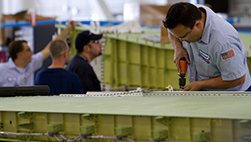by Mark Robins
 AVM professionals are faced with a huge range of different tools to service, repair, over haul and maintain many a wide assortment of aircraft to ensure their structural soundness. The size and type of an AVM tool will differ from one aircraft to another because of differences in aircraft size. Engine and hydraulic AVM mechanics will have very large wrenches, while electricians and avionics technicians will have precision screwdrivers.
AVM professionals are faced with a huge range of different tools to service, repair, over haul and maintain many a wide assortment of aircraft to ensure their structural soundness. The size and type of an AVM tool will differ from one aircraft to another because of differences in aircraft size. Engine and hydraulic AVM mechanics will have very large wrenches, while electricians and avionics technicians will have precision screwdrivers.
Regardless of their size or use, as any aircraft evolves, so must the tools that support it. Advances in AVM tools allow AVM professionals to work on the latest materials and newest application specifications while complying with regulations, and troubleshooting, diagnosing and correcting discrepancies. Some AVM tools like hammers and screwdrivers have remained unchanged with only slight alteration; others have evolved to become state of the art.
New advances in tools not only aid overall aircraft maintenance, but also worker safety and ergonomics. “Like any industry, there is a need to work quicker and more efficiently,” said Dan Riccio brand manager of hand tools & storage, Stanley Black & Decker. “At the same time, a premium is placed on worker safety to avoid unintended injury by not only jobsite dangers, but overuse injuries. To fill this void, many manufacturers are designing tools to be more ergonomic. By designing with ergonomics in mind, it helps any industry, including aviation, to improve worker safety, performance, and profitability.”
“Tools and tool management systems within aviation maintenance are developed to enable the technician to work safer, to improve the quality of the maintenance task, and to do the job with greater ease,” said Andy Lobo, director-produce management and development at Snap-on Industrial. “When these developments are adopted widely, the seconds of time saved on a task by using a new tool or system quickly add up to man-hours, man-days, man-months and even man-years (sic) of savings, collectively advancing the whole of the aviation industry.”
Ergonomic advances
Fundamental designs in AVM tools are being made to make them lighter and easier to use. For example, the basics of installing and removing rivets have not changed much in 50 years. However, newly designed tools make it easier and safer on the operator to produce better quality riveting more consistently.
“Tooling advancements help reduce the risk of injury for technicians who work on aircraft and can also help decrease the risk of damage to aircraft,” stated Paul Dellinger, director of environmental health and safety, Gulfstream Aerospace Corporation. “New and better tooling also helps to maximize work efficiency. Many of our advances in tooling come to us internally. This is, in large part, the result of our safety management system and continuous improvement culture at Gulfstream, which encourages technicians to improve a process or suggest the customization of a tool to make it better. We also look at a tremendous amount of data, which helps us identify an issue and gets us to the point where we can begin to design or select a better tool.”
Another example is socket usage. Sockets are often called upon to break loose very stubborn fasteners in some very access-restricted areas on aircraft. “For the socket to work in such a confined space, its walls have to be thin and strong,” said Lobo. “Thin and strong is a dichotomy unless you pick the right materials and have extremely tight tolerances on your sockets. Snap-on spline sockets are a good example of this, utilizing steel with up to 80 percent greater yield strength than most other tool steels used to make sockets.”